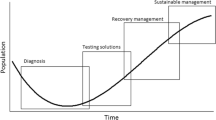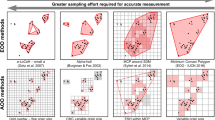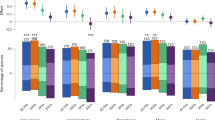Abstract
Surrogacy analysis consists of determining a set of biotic or environmental parameters which can be rapidly assessed in the field and reliably used to prioritize places for biodiversity conservation. Whether adequate surrogate sets exist remains an open and relatively unexplored question though its solution is central to the aims of conservation biology. This paper analyses the surrogacy problem by prioritizing places using surrogate lists and comparing these results with those obtained by using more comprehensive species lists. More specifically, it explores (i) the possibility of using bird distributions, which are often easily available, as surrogates for species at risk (endangered and threatened species), which are presumed to be an important component of biodiversity; and (ii) the methodological question of how spatial scale influences surrogate success. The data set analysed, from southern Québec, is one of the most complete biotic data sets available at the regional scale. Contrary to some previous analyses, the results obtained suggest that the surrogacy problem is potentially solvable.
Similar content being viewed by others
References
Aggarwal A, Garson J, Margules C R, Nicholls A O and Sarkar S 2000ResNet Ver 1.1 Manual, Report, Biodiversity and Biocultural Conservation Laboratory, University of Texas, Austin
Andelman S J and Fagan W F 2000 Umbrellas and flagships: efficient conservation surrogates, or expensive mistakes?;Proc. Natl. Acad. Sci. USA 97 5954–5959
Balmford A and Gaston K J 2001 Why biodiversity surveys are good value;Nature (London) 398 204–205
Balmford A and Long A 1995 Across-country analyses of biodiversity congruence and current conservation effort in the tropics;Conserv. Biol. 9 1539–1547
Brower L P and Malcolm S B 1991 Animal migrations: endangered phenomena;Am. Zool. 31 265–276
Colwell R K S and Coddington J A 1994 Estimating terrestrial biodiversity through extrapolation;Philos. Trans. R. Soc. London B345 101–108
Csuti B, Polasky S, Williams P H, Pressey R L, Camm J D, Kershaw M, Kiester A R, Downs B, Hamilton R, Huso M and Sahr K 1997 A comparison of reserve selection algorithms using data on terrestrial vertebrates in Oregon;Biol. Conserv. 80 83–97
Faith D P and Walker P A 1996 How do indicator groups provide information about the relative biodiversity of different sets of areas?: on hotspots, complementarity and pattern-based approaches;Biodiver. Lett. 3 18–25
Ferrier S and Watson G 1997An evaluation of the effectiveness of environmental surrogates and modelling techniques in predicting the distribution of biological diversity. Consultancy report to the Biodiversity Convention and Strategy Section of the Biodiversity Group, Environment Australia (New South Wales: Environment Australia)
Howard P C, Viskanic P, Davenport T, Kigenyi F, Baltzer M, Dickinson C, Lwanga J, Matthews R and Balmford A 1998 Complementarity and the use of indicator groups for reserve selection in Uganda;Nature (London)394 472–475
Justus J and Sarkar S 2002 The principle of complementarity in the design of reserve networks to conserve biodiversity; a preliminary history;J. Biosci. (Suppl. 2)27 421–435
Landres P B, Verner J and Thomas J W 1988 Ecological uses of vertebrate indicator species: a critique;Conserv. Biol. 2 316–328
Lawton J H, Bignell D E, Boulton B, Bloemers G F, Eggleton P, Hammond P M, Hodda M, Holt R D, Larsen T B, Mawdsley N A, Stork N E, Srivastava D S and Watt A D 1998 Biodiversity inventories, indicator taxa and effects of habitat modification in tropical forest;Nature (London)391 72–76
Margules C R, Nicholls A O and Pressey R L 1988 Selecting networks of reserves to maximize biological diversity;Biol. Conserv. 43 63–76
Margules C R and Pressey R L 2000 Systematic conservation planning;Nature (London)405 243–253
Nix H A, Faith D P, Hutchinson M F, Margules C R, West J, Allison A, Kesteven J L, Natera G, Slater W, Stein J L and Walker P 2000The BioRap toolbox: A national study of biodiversity assessment and planning for Papua New Guinea. Consultancy report to the World Bank (Canberra: CSIRO Press)
Polasky S, Camm J D, Solow A R, Csuti B, White D and Ding R 2000 Choosing reserve networks with incomplete species information;Biol. Conserv. 94 1–10
Prendergast J R, Quinn R M, Lawton J H, Eversham B C and Gibbons D W 1993 Rare species, the coincidence of diversity hotspots and conservation strategies;Nature (London)365 335–337
Pressey R L and Cowling R M 2001 Reserve selection algorithms and the real world;Conserv. Biol. 15 275–277
Rebelo A G and Siegfried W R 1992 Where should nature reserves be located in the Cape Floristic Region, South Africa? Models for the spatial configuration of a reserve network aimed at maximizing the protection of floral diversity;Conserv. Biol. 6 243–252
Sarakinos H, Nicholls A O, Tubert A, Aggarwal A, Margules C R and Sarkar S 2001 Area prioritization for biodiversity conservation in Québec on the basis of species distributions: a preliminary analysis;Biodiver. Conserv. (in press)
Sarkar S 2001 Defining "biodiversity"; assessing biodiversity;Monist (in press)
Sarkar S and Margules C 2001 Operationalizing biodiversity for conservation planning;J. Biosci. (Suppl. 2)27 299–308
Sarkar S, Parker N, Garson J, Aggarwal A and Haskell S 2001 Place prioritization for Texas using GAP data: the use of biodiversity and environmental surrogates within socioeconomic constraints;Gap Bull. (in press)
Simberloff D 1998 Flagships, umbrellas, and keystones: is single species management passé in the landscape era?;Biol. Conserv. 83 247–257
Williams P, Gibbons D, Margules C, Rebelo A, Humphries C and Pressey R 1996 A comparison of richness hotspots, rarity hotspots, and complementary areas for conserving diversity of British birds;Conserv. Biol. 10 155–174
Vane-Wright R I, Humphries C J and Williams P H 1991 What to protect? Systematics and the agony of choice;Biol. Conserv. 55 235–254
Author information
Authors and Affiliations
Corresponding author
Rights and permissions
About this article
Cite this article
Garson, J., Aggarwal, A. & Sarkar, S. Birds as surrogates for biodiversity: An analysis of a data set from southern Québec. J Biosci 27, 347–360 (2002). https://doi.org/10.1007/BF02704965
Issue Date:
DOI: https://doi.org/10.1007/BF02704965




